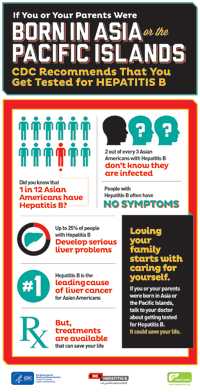Know Hepatitis B
On this Page
National CDC Campaign to Increase Testing among Asian Americans and Pacific Islanders
Click on a graphic to see it in high-resolution
Included below are campaign images and an infographic available for download. These high-resolution, public domain images are ready to print in your publication campaign images available for download. These high-resolution, public domain images are ready to print in your publication.
These images are in the public domain and are thus free of any copyright restrictions. As a matter of courtesy, we request that the content provider be credited and notified of any public or private usage of an image.
If you are interested in further campaign information, please visit Know Hepatitis B.
Know Hepatitis B – Infographic
 Hepatitis B among Asian Americans and Pacific Islanders
Hepatitis B among Asian Americans and Pacific Islanders
Download High Resolution Version
In the United States, Asian Americans and Pacific Islanders are one of the groups most affected by hepatitis B, which can cause potentially fatal liver damage, including liver cancer. Although this group makes up less than 5 percent of the U.S. population, they account for more than half of the 1.2 million Americans estimated to be living with hepatitis B. Hepatitis B is especially common in many Asian and Pacific Island countries, and many with chronic hepatitis B became infected as infants or young children. It is usually spread when someone comes into contact with blood from someone who has the virus.
It is estimated that 1 in 12 Asian Americans and Pacific Islanders is living with hepatitis B. Yet, as many as 2 in 3 of those do not know they are infected, because the disease often has no symptoms until serious liver damage has already occurred – usually decades after they are first infected. Testing allows those with hepatitis B to take steps to protect their health, including accessing care and starting treatment that can delay or reverse the effects of liver disease.
Infographic – Printable PDF
- Page last reviewed: June 12, 2013
- Page last updated: December 27, 2013
- Content source:


 ShareCompartir
ShareCompartir



